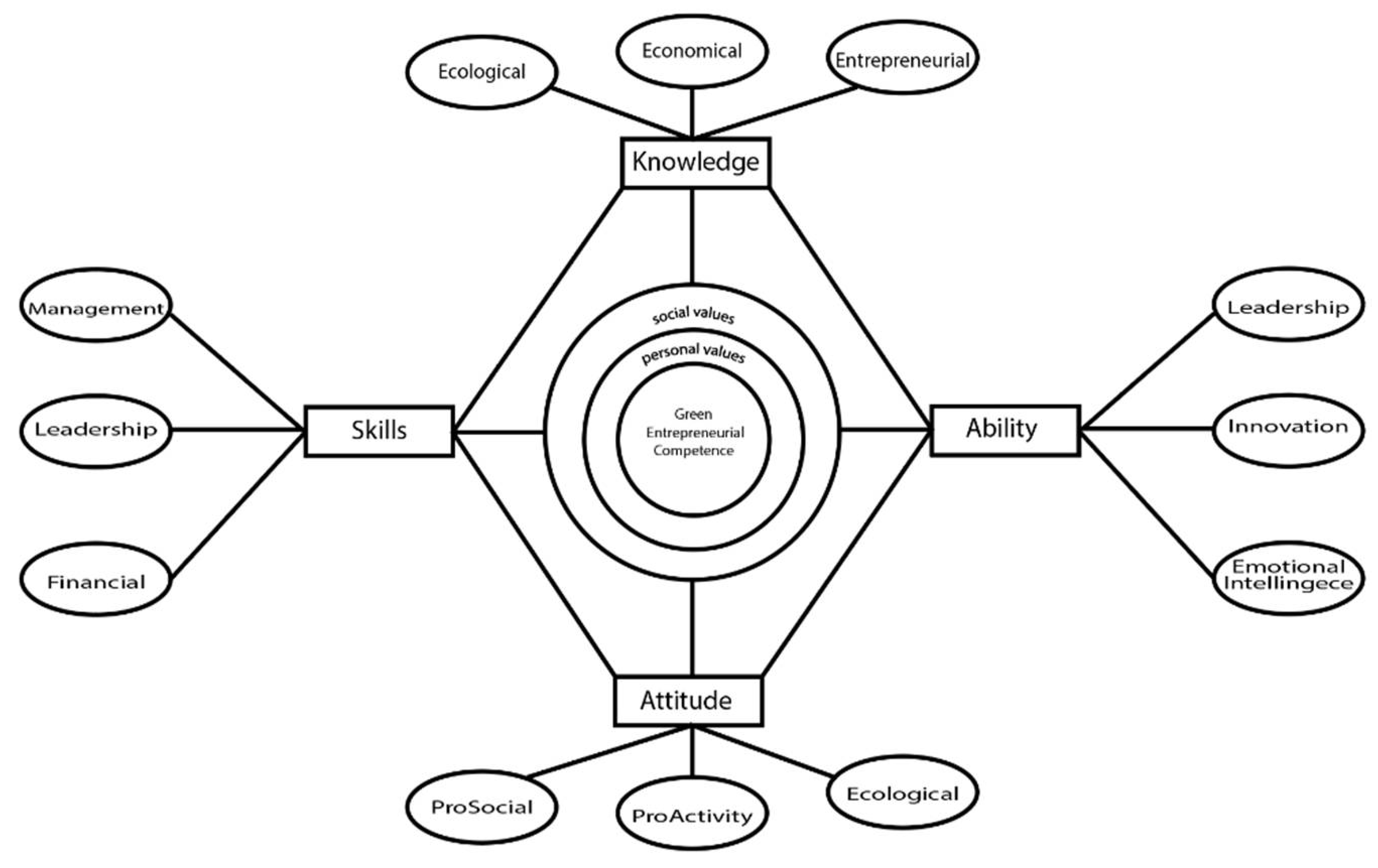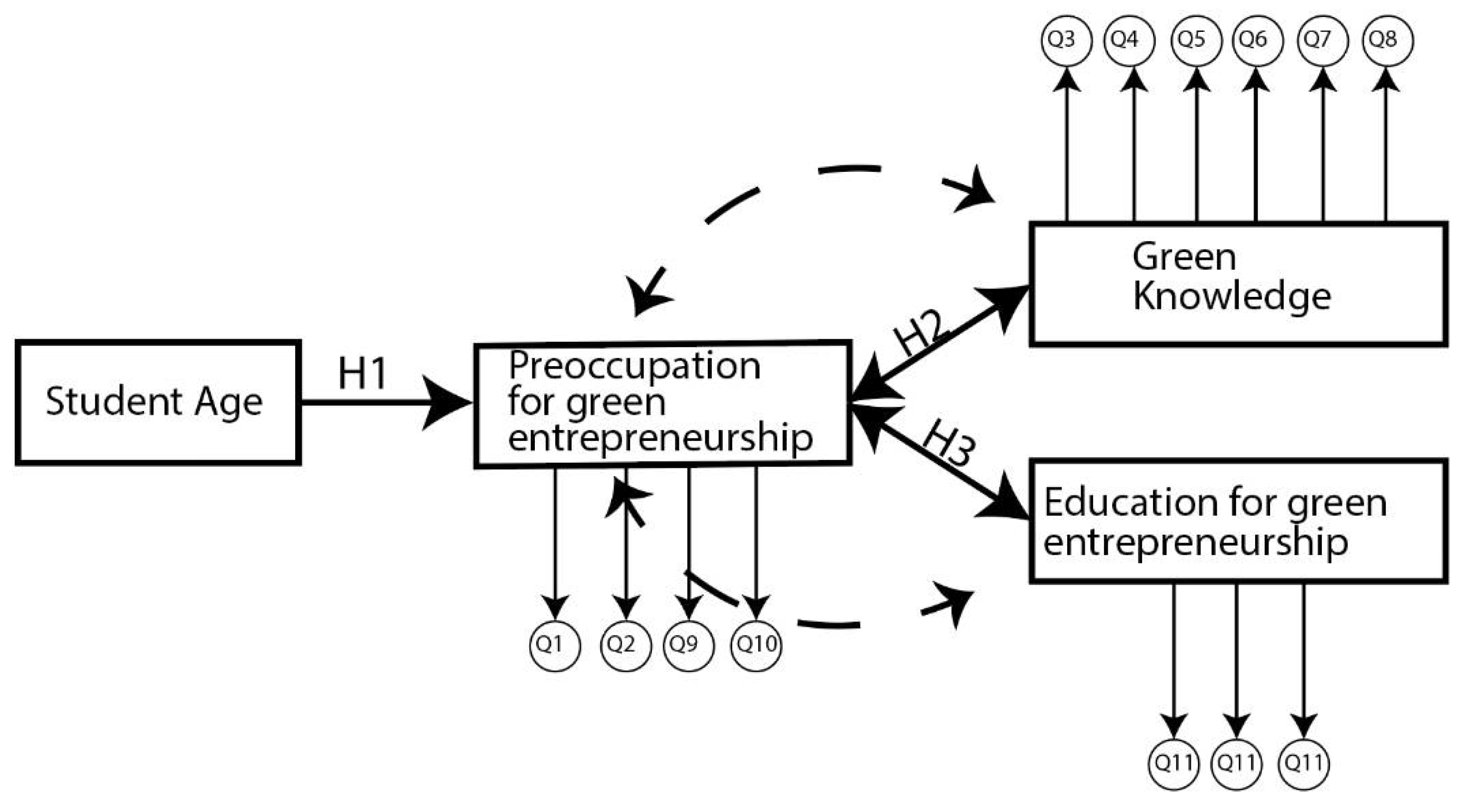The literature of the specialty operates with various definitions of the concept of “Green entrepreneurship” [
12,
13]. Green entrepreneurship represents the process of creating products and services which are fully needed to create sustainable development [
14]; the total amount of activities that have the purpose to resolve environmental challenges and problems [
15]. Therefore, green entrepreneurship can be defined as a business activity that generates profit that can be applied to environmental protection actions. In the context of education for sustainability development, the need for green competencies is formed among passionate people and it encourages entrepreneurs to access this challenging market. The literature of the specialty offers various definitions for green entrepreneurship. As it follows below, it will be analyzed by considering a specific set of interpretative paradigms: psychological, sociological, and educational. These theories served the process of analyzing and interpreting the results of the research and supported the explanation regarding the factors which influence the entrepreneurial competencies among students.
2.1. The Psychological Paradigm
The psychological paradigm over green entrepreneurship is concentrating on explaining the human behavior and the social consciousness of individuals [
16] in various contexts: ecological, economic, and business administration. The psychological paradigm will define the relations between social thinking, public social consciousness, and social representations of green entrepreneurship. Nonetheless, the psychological paradigm will also bring attention to the social behaviors of individuals that are strongly influenced by social thinking and the individual report on future events, in the context of sustainable development. In a green society, the reconstruction of social thinking can be explained by people reflecting on problems that affect life on the planet and creating value judgment thoughts based on their values and perspectives. Regarding social thinking, it is appreciated that it is explained in the context of considering the formed dimension of “public social consciousness”.
Social knowledge is based on cognitions with a strong social character [
17,
18]. Social thinking is strongly influenced by the moral, economic, and cultural history of a social group of people [
19]. The explanation of the process regarding “how do people think in specific common situations in society?” can be considered by the fact that the environment in which an individual lives and develops sends them information over their interpretation. Social thinking has a cultural determent factor. More precisely, the culture of a society influences not only the understanding of facts and social processes but also the way individuals adapt their attitudes and behaviors in different social contexts. Reporting to different problems regarding the Earth’s ecological situation integrates the expression of an individual’s reflective capacity [
20] and is characterized by assimilation and operates with information and knowledge, identifying problems, especially environment-wise, operating with possible solutions, examples of special and unique solutions, understanding of facts and ecological processes, adapting to shifting contexts of the environment. The social context “influences thinking, marks it, but it also determines the social practices has a motivational role, can determine conformism, stereotypical thinking, can create cognitive base structures which can be manipulated from an external place” [
16].
Motivation has a strong social character and, in the context of green entrepreneurship, because of specific external conditions of the individual which facilitate the development of entrepreneurship, a high number of individuals will start having common interests and actions in this direction. Also, the reasons, intentions, and personal and group ideals cannot be understood outside of social, cultural, and historical contexts [
21]. The entrepreneurship type of thinking and actions are focusing on collecting data and information, understanding them, and making clear decisions [
22].
The key elements of the managers’ behavior structure (cognitive, psychological, and emotional) influence their decision process. Both positive and negative emotions may influence the managers’ decision process regarding their directions of action and financial management [
23]. Behavioral development is strongly influenced by the development of the affective and cognitive components [
24]. Analyzing the psychological paradigm, we may draw the following conclusion: behaviors are strongly influenced by cognitions, emotions, and motivations, by personal and social values. Education plays a major role in their modeling. The preoccupation with green affairs bears a powerful emotional print, given the interest in increasing the quality of personal and social life. The accurate awareness of the problems concerning the health of the planet positively influences the attitude towards the environment and represents an essential precursor for green entrepreneurship. Acknowledging the importance of social action using green entrepreneurship is closely influenced by age. That is why the Start-Apps are especially destined for youngsters who have not yet turned 26.
2.3. The Education Paradigm
The Education Paradigm for sustainability attracts attention to the need of forming and developing entrepreneurship competencies, identified as key elements of the 21st century [
28]. The development of entrepreneurship competencies among people and the need for education in sustainability can be the start of the green entrepreneurship [
29]. Therefore, it is to be reminded that in 1987, the World Commission on Environment and Development or the Brundtland Committee [
30] “proposes that the most known and accepted definition of sustainable development like satisfying the needs of future generations, without compromising the possibility of future generations to satisfy their own needs”. The education for durable development (EDD) [
31] “allows for every human being to gather the knowledge competencies, behaviors, and values that are necessary to create a sustainable future”.
In the context of the same research, it is to be understood that in a declaration of Irina Bokova, UNESCO General Director, “Education for durable development has a very well-balanced effect on the wellbeing of individuals and the future of our planet”. Now, more than ever, education has the responsibility to adapt its speed to all challenges and aspirations of the 21st century and to promote the correct type of values and skills that will lead to a sustainable and inclusive rise and common wellbeing.
Green entrepreneurship has at its core the green education, which is believed to represent the forming process and development place of competencies for durable development (necessary knowledge, skills, and behaviors that are crucial for sustainable living and to change purchase behavior to contribute to a more ecological future) [
30]. Recent speeches regarding the need for education for sustainability bring attention to the discussion about green competencies [
7,
32] described through green knowledge, skills, and behaviors. In the category of green knowledge, according to European strategy in the green education field, specific disciplines can be highlighted such as engineering, production, construction (wind turbines and durable installation materials), natural sciences, mathematics, statistics (ecological principles, biomass conversion, oceanography), agriculture, silviculture, business administration, and law. Also, services like social sciences can be added, as well as the technology of information such as journalism, health, and wellbeing.
In the category of transversal competencies, it is important to be reminded of life abilities and skills (the evaluation of the impact on the unique environment, adopting new ways to promote the biodiversity and wellbeing of animals, reaching for new methods of reducing the negative level and effects of consumerism). According to other authors, green entrepreneurship represents the added value to the culture of a company [
33].
Green entrepreneurship among students has represented a research subject for various scientists, most of whom were interested in researching the intention of students and their contact and perspective on green entrepreneurship and the relations between the variables that influence it [
34]. This new but existing field of green entrepreneurship among students is determined by a series of factors [
35] such as individual and external elements. As for the individual factors, it is to be mentioned that the most important are the entrepreneurial personality and the spirit itself within the logical thinking, rationality, creativity, power of will, the spirit of a winner, tenacity, perseverance, logic or argumentation, persuasion, honesty, team spirit, pragmatism, sociability, etc. In the category of external factors which sustain the development of green entrepreneurship, it is to be mentioned that elements like entrepreneurial, ecological, and economic education are important. There is a series of variables that can positively or negatively influence the evolution of green entrepreneurship. When it comes to positive factors through which green entrepreneurship can be stimulated, some good examples are external factors (correctly applied environmental and fiscal development opportunities policies) and internal factors (positive personal motivation “I want to save the planet”, well-formed and represented entrepreneurial competences, ecological and economic education, etc.). In the category of factors that can negatively influence the development of green business, essential elements are business policies (the bureaucracy of processes, errors in understanding of facts regarding the problems that will occur in the future of planet Earth, errors in managing a green business, the absence of sustainable perspectives regarding the future of the green business, etc.) and factors regarding the administration method of the business (low entrepreneurial competences, unsustainable business, errors in administrating resources and in implementing the management and marketing processes, etc.). Entrepreneurial competence in the context of European educational policies is a crucial component. Researching the literature of the specialty over the definition of entrepreneurial competence identified as an entrepreneurial key component, according to Robles, L. & Rodriguez, Z [
36], has the following characteristics: taking risks, autonomy, search and analysis of information quality of work communication, self-confidence, develop social networks, generation of support networks, dynamism change management, initiative innovation integrity, leadership, self-control, results in orientation, social mobility, negotiation troubleshooting, responsibility, and teamwork (
Figure 1).
The educational policies claim the implementation of educational processes based on forming and developing key competencies among learners. The structure of entrepreneurial competencies can be analyzed in
Figure 1. The competency for green entrepreneurship among students can be described as the student’s capacity to create a green business using information and knowledge gained previously (economic, ecological, and administrative) and of forming and developing attitudes and skills specific to green entrepreneurship [
37]. All of these are strongly influenced by a system of values (internal and social) and by social, economic, political, and cultural contexts which facilitate the active usage of competencies in green entrepreneurship [
9,
38].
Within the context of the explicative paradigms, the main factors which influence entrepreneurship are the entrepreneur’s competencies and abilities, the access to financing sources, taxes and other administrative barriers, the existence of networks and connections, the culture and the entrepreneurial capital, the entrepreneurial education, and public policies.
We are facing the following questions: In what measure are today’s students’ own entrepreneurial competencies and are they interested in the future development of green entrepreneurship? In what measure do the three dimensions—entrepreneurial education, green knowledge, and preoccupation with green entrepreneurship—correlate within the context of green entrepreneurship? What is the impact that green entrepreneurial education and green knowledge have on the students’ preoccupation to accomplish green entrepreneurship? The social character of the motivation regarding the students’ involvement in green entrepreneurship is given by the policies concerning the sustainable development perspectives and by the responsibility with which they correctly get involved in protecting the environment. The concept of “well-being”, both on individual and social plans, within the sustainable development context represents free-standing motivational vectors that intervene in adopting green behaviors, in making decisions regarding the perspective of individual involvement in protecting the planet. The social, economic, political, and cultural contexts are influencing the intentions, goals, and ideals [
37].









